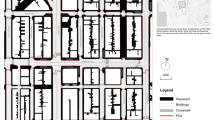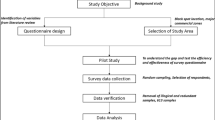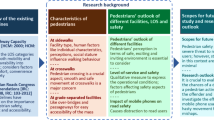Abstract
Violations, risky behaviors and perceptions may largely contribute to crashes involving pedestrians, particularly at unmarked mid-block locations. The likelihood and severity of crashes at mid-block locations are higher compared to intersections. This study explores pedestrians’ behaviors at and perceptions about unmarked mid-block locations. The data were collected through an online questionnaire survey that included 24 questions with 5-point Likert-type responses on behaviors, mobility patterns, preferences, perceptions and attitudes of pedestrians along with demographic questions. Two hundred and twenty responses were collected from various regions (developing and developed countries). Exploratory factor analysis was performed, and four underlying factors, namely “risk-taking,” “wrong-perceptions,” “walking-for-pleasure,” and “walking-pattern,” that describe perceptions and behaviors associated with unmarked mid-block crossings were identified. The influence of demographic parameters on the factor scores was also examined. Males displayed higher wrong-perceptions about crossing the road at unmarked mid-block locations as compared to females. The region was found to have a significant impact on wrong-perceptions between developing and developed countries. Further, cluster analysis on the factor scores resulted in four distinct clusters of pedestrians, namely; non-risky walkers, non-walkers, risk-takers and unaware walkers. The findings of this study provide valuable insights into pedestrian behavior and perceptions towards crossing at unmarked mid-block locations and could be useful in enhancing pedestrian safety at such locations.










Similar content being viewed by others
References
Agarwal S, Vikram D (2021) Impact of vehicular traffic stream on pedestrian crossing behavior at an uncontrolled mid-block section. Transp Res Interdiscip Perspectives 9:100298
Aguinis H, Gottfredson RK, Joo H (2013) Best-practice recommendations for defining, identifying, and handling outliers. Organ Res Methods 16(2):270–301
Al-Masaeid HR, Obaidat MT, Gharaybeh FA (1997) Pedestrian accidents along urban arterial midblocks. J Traffic Med 25(3–4):65–70
Alver Y, Onelcin P, Cicekli A, Abdel-Aty M (2021) Evaluation of pedestrian critical gap and crossing speed at midblock crossing using image processing. Accid Anal Prev 156:106127
Antić B, Pešić D, Milutinović N, Maslać M (2016) Pedestrian behaviours: validation of the Serbian version of the pedestrian behaviour scale. Transp Res Part F Traffic Psychol Behav 41:170–178
Avinash C, Jiten S, Arkatkar S, Gaurang J, Manoranjan P (2019) Evaluation of pedestrian safety margin at mid-block crosswalks in India. Saf Sci 119:188–198
Avineri E, Shinar D, Susilo YO (2012) Pedestrians’ behaviour in cross walks: the effects of fear of falling and age. Accid Anal Prev 44(1):30–34
Brosseau M, Zangenehpour S, Saunier N, Miranda-Moreno L (2013) The impact of waiting time and other factors on dangerous pedestrian crossings and violations at signalized intersections: A case study in Montreal. Transp Res Part F Traffic Psychol Behav 21:159–172
Cantillo V, Arellana J, Rolong M (2015) Modelling pedestrian crossing behaviour in urban roads: a latent variable approach. Transp Res Part F Traffic Psychol Behav 32:56–67
Chu X (2006) Pedestrian safety at midblock locations. https://trid.trb.org/view/790891
Deb S, Strawderman L, DuBien J, Smith B, Carruth DW, Garrison TM (2017) Evaluating pedestrian behavior at crosswalks: Validation of a pedestrian behavior questionnaire for the US population. Accid Anal Prev 106:191–201
Dıaz EM (2002) Theory of planned behavior and pedestrians’ intentions to violate traffic regulations. Transp Res Part F Traffic Psychol Behav 5(3):169–175
DiStefano C, Zhu M, Mindrila D (2009) Understanding and using factor scores: considerations for the applied researcher. Pract Assess Res Eval 14(1):20
Elliott MA, Baughan CJ (2003) Adolescent road user behaviour: a survey of 11–16 year olds. TRL Report 561, Crowthorne: transport research laboratory
Evans D, Norman P (1998) Understanding pedestrians’ road crossing decisions: an application of the theory of planned behaviour. Health Educ Res 13(4):481–489
Ferenchak NN (2016) Pedestrian age and gender in relation to crossing behavior at midblock crossings in India. J Traffic Transp Eng (english Edition) 3(4):345–351
Figliozzi MA, Tipagornwong C (2016) Pedestrian Crosswalk Law: a study of traffic and trajectory factors that affect non-compliance and stopping distance. Accid Anal Prev 96:169–179
Gaskin CJ, Happell B (2014) On exploratory factor analysis: a review of recent evidence, an assessment of current practice, and recommendations for future use. Int J Nurs Stud 51(3):511–521
Granié MA (2009) Effects of gender, sex-stereotype conformity, age and internalization on risk-taking among adolescent pedestrians. Saf Sci 47(9):1277–1283
Granié MA, Pannetier M, Gueho L (2013) Developing a self-reporting method to measure pedestrian behaviors at all ages. Accid Anal Prev 50:830–839
Guerin C, Jayatilaka A, Ranasinghe D (2015) Why start a higher degree by research? An exploratory factor analysis of motivations to undertake doctoral studies. High Educ Res Dev 34(1):89–104
Hershberger SL (2005) Factor scores. In: EverittandD BS, Howell C (eds) Encyclopedia of statistics in behavioralscience. John Wiley, New York, pp 636–644
Holland C, Hill R (2007) The effect of age, gender and driver status on pedestrians’ intentions to cross the road in risky situations. Accid Anal Prev 39(2):224–237
Kadali BR, Vedagiri P (2020) Role of number of traffic lanes on pedestrian gap acceptance and risk taking behaviour at uncontrolled crosswalk locations. J Transp Health 19:100950
Louangrath PI, Sutanapong C (2018) Validity and reliability of survey scales. Int J Res Methodol Soc Sci 4:99–115
MacCallum RC, Widaman KF, Zhang S, Hong S (1999) Sample size in factor analysis. Psychol Methods 4(1):84
Mukherjee D, Mitra S (2020) Modelling risk factors for fatal pedestrian crashes in Kolkata, India. Int J Inj Contr Saf Promot 27(2):197–214
Murtagh F, Contreras P (2012) Algorithms for hierarchical clustering: an overview. Wiley Interdiscip Rev Data Min Knowl Discov 2(1):86–97
Nordfjærn T, Şimşekoğlu Ö (2013) The role of cultural factors and attitudes for pedestrian behaviour in an urban Turkish sample. Transp Res Part F Traffic Psychol Behav 21:181–193
Norman G (2010) Likert scales, levels of measurement and the “laws” of statistics. Adv Health Sci Educ 15(5):625–632
Onelcin P, Alver Y (2017) The crossing speed and safety margin of pedestrians at signalized intersections. Transp Res Proc 22:3–12
Osborne JW (2015) What is rotating in exploratory factor analysis? Pract Assess Res Eval 20(1):2
Osborne JW, Costello AB, Kellow JT (2014) Best practices in exploratory factor analysis. CreateSpace Independent Publishing Platform, Louisville, KY, pp 86–99
Papadimitriou E (2016) Towards an integrated approach of pedestrian behaviour and exposure. Accid Anal Prev 92:139–152
Papadimitriou E, Theofilatos A, Yannis G (2013) Patterns of pedestrian attitudes, perceptions and behaviour in Europe. Saf Sci 53:114–122
Papadimitriou E, Lassarre S, Yannis G (2016) Introducing human factors in pedestrian crossing behaviour models. Transp Res Part F Traffic Psychol Behav 36:69–82
Papadimitriou E, Lassarre S, Yannis G (2017) Human factors of pedestrian walking and crossing behaviour. Transp Res Proc 25:2002–2015
Papić Z, Jović A, Simeunović M, Saulić N, Lazarević M (2020) Underestimation tendencies of vehicle speed by pedestrians when crossing unmarked roadway. Accid Anal Prev 143:105586
Peng H, Ma X, Chen F (2020) Examining injury severity of pedestrians in vehicle-pedestrian crashes at mid-blocks using path analysis. Int J Environ Res Public Health 17(17):6170
Qu W, Zhang H, Zhao W, Zhang K, Ge Y (2016) The effect of cognitive errors, mindfulness and personality traits on pedestrian behavior in a Chinese sample. Transp Res Part F Traffic Psychol Behav 41:29–37
Rankavat S, Tiwari G (2020) Influence of actual and perceived risks in selecting crossing facilities by pedestrians. Travel Behav Soc 21:1–9
Rastogi R, Thaniarasu I, Chandra S (2011) Design implications of walking speed for pedestrian facilities. J Transp Eng 137(10):687–696
Rosenbloom T, Sapir-Lavid Y, Hadari-Carmi O (2009) Social norms of accompanied young children and observed crossing behaviors. J Safety Res 40(1):33–39
Sheykhfard A, Haghighi F, Papadimitriou E, Van Gelder P (2021) Analysis of the occurrence and severity of vehicle-pedestrian conflicts in marked and unmarked crosswalks through naturalistic driving study. Transp Res Part F Traffic Psychol Behav 76:178–192
Shrestha N (2021) Factor analysis as a tool for survey analysis. Am J Appl Math Stat 9(1):4–11
Soathong A, Chowdhury S, Wilson D, Ranjitkar P (2021) Investigating the motivation for pedestrians’ risky crossing behaviour at urban mid-block road sections. Travel Behav Soc 22:155–165
Sullman MJ, Mann HN (2009) The road user behaviour of New Zealand adolescents. Transp Res Part F Traffic Psychol Behav 12(6):494–502
Sullman MJ, Gras ME, Font-Mayolas S, Masferrer L, Cunill M, Planes M (2011) The pedestrian behaviour of Spanish adolescents. J Adolesc 34(3):531–539
Sullman MJ, Thomas A, Stephens AN (2012) The road user behaviour of school students in Belgium. Accid Anal Prev 48:495–504
Tarko A, Azam MS (2011) Pedestrian injury analysis with consideration of the selectivity bias in linked police-hospital data. Accid Anal Prev 43(5):1689–1695
Tiwari G, Bangdiwala S, Saraswat A, Gaurav S (2007) Survival analysis: pedestrian risk exposure at signalized intersections. Transp Res Part F Traffic Psychol Behav 10(2):77–89
Toran Pour A, Moridpour S, Tay R, Rajabifard A (2017) Modelling pedestrian crash severity at mid-blocks. Transportmetrica A Transp Sci 13(3):273–297
Useche SA, Hezaveh AM, Llamazares FJ, Cherry C (2021) Not gendered but different from each other? A structural equation model for explaining risky road behaviors of female and male pedestrians. Accid Anal Prev 150:105942
Vaske JJ, Beaman J, Sponarski CC (2017) Rethinking internal consistency in Cronbach’s alpha. Leis Sci 39(2):163–173
Williams B, Onsman A, Brown T (2010) Exploratory factor analysis: a five-step guide for novices. Australas J Paramed 8(3)
Woods DL, Wyma JM, Yund EW, Herron TJ, Reed B (2015) Age-related slowing of response selection and production in a visual choice reaction time task. Front Hum Neurosci 9:193
World Health Organization (2018) Global status report on road safety 2018 (2018). https://www.who.int/violence_injury_prevention/road_safety_status/2018/en/. Accessed 24 Feb 2020
Yagil D (2000) Beliefs, motives and situational factors related to pedestrians’ self-reported behavior at signal-controlled crossings. Transp Res Part F Traffic Psychol Behav 3(1):1–13
Yong AG, Pearce S (2013) A beginner’s guide to factor analysis: focusing on exploratory factor analysis. Tutor Quant Methods for Psychol 9(2):79–94
Zhang C, Zhou B, Qiu TZ, Liu S (2018) Pedestrian crossing behaviors at uncontrolled multi-lane mid-block crosswalks in developing world. J Safety Res 64:145–154
Zhang C, Chen F, Wei Y (2019) Evaluation of pedestrian crossing behavior and safety at uncontrolled mid-block crosswalks with different numbers of lanes in China. Accid Anal Prev 123:263–273
Zheng Y, Chase T, Elefteriadou L, Schroeder B, Sisiopiku VP (2015) Modeling vehicle–pedestrian interactions outside of crosswalks. Simul Model Pract Theory 59:89–101
Funding
This study received no funding.
Author information
Authors and Affiliations
Contributions
The authors confirm contribution to the paper as follows: study conception and design: Abdullah, Oguchi and Dias; data collection: Abdullah, Dias and Oguchi; analysis and interpretation of results: Abdullah and Dias; draft manuscript preparation: Abdullah and Dias. All authors reviewed the results and approved the final version of the manuscript.
Corresponding author
Ethics declarations
Conflicts of Interest
The authors declare no conflict of interest.
Rights and permissions
About this article
Cite this article
Abdullah, M., Dias, C. & Oguchi, T. Road Crossing at Unmarked Mid-Block Locations: Exploring Pedestrians’ Perception and Behavior. Iran J Sci Technol Trans Civ Eng 46, 1681–1698 (2022). https://doi.org/10.1007/s40996-021-00701-z
Received:
Accepted:
Published:
Issue Date:
DOI: https://doi.org/10.1007/s40996-021-00701-z




